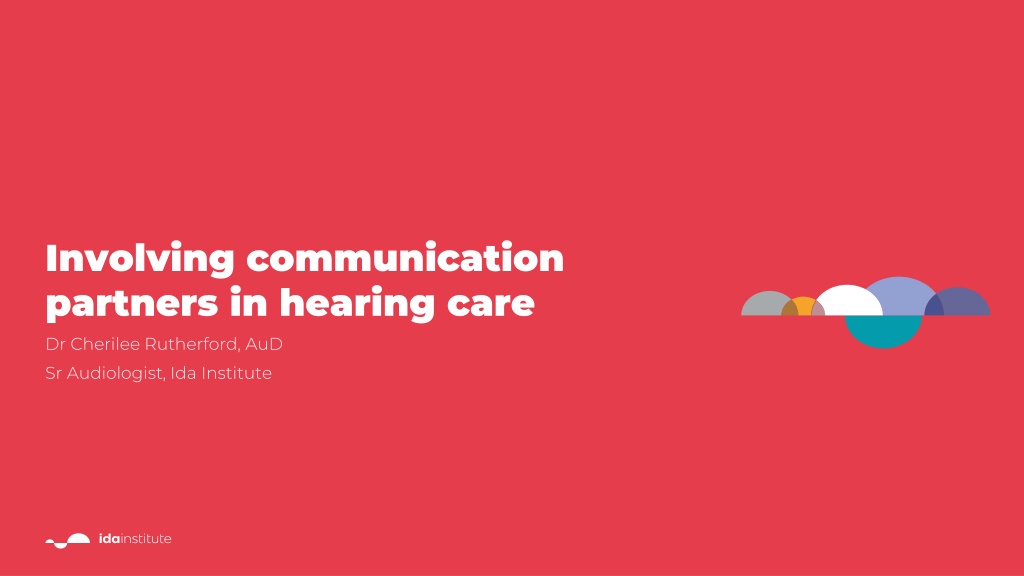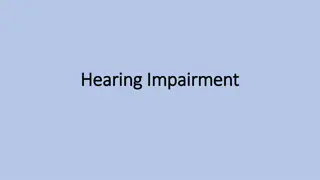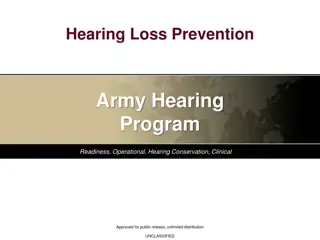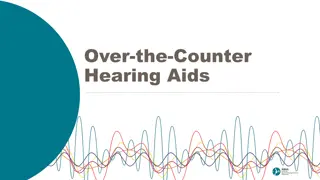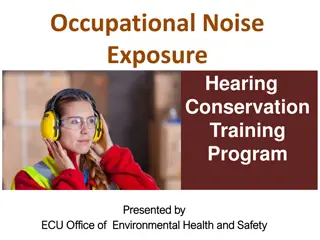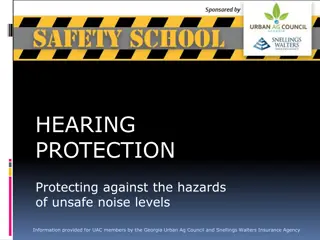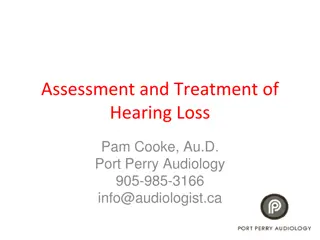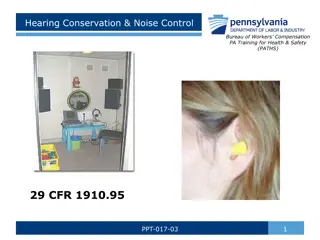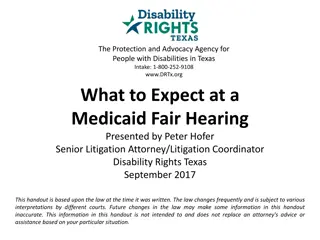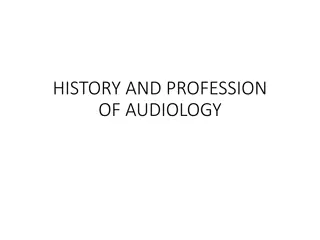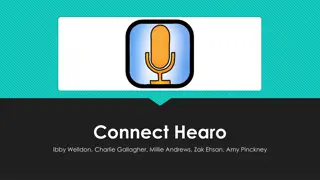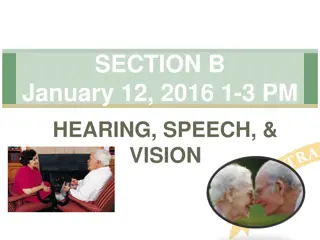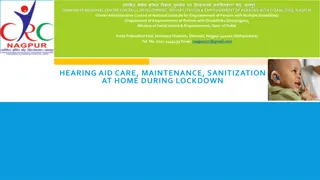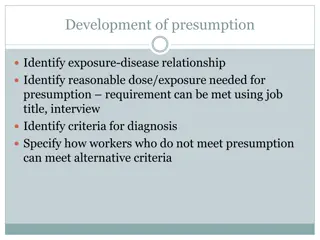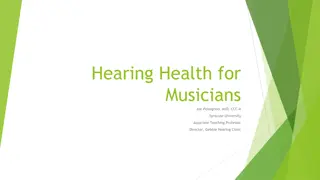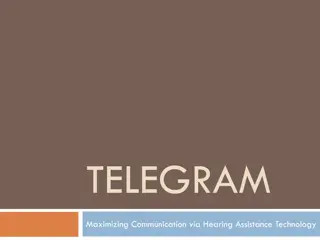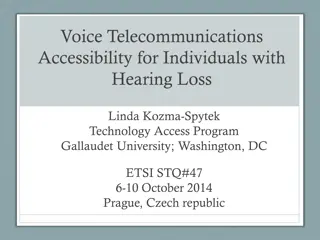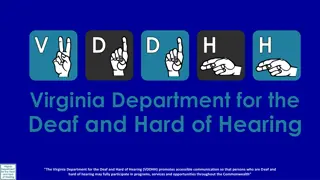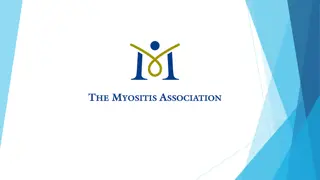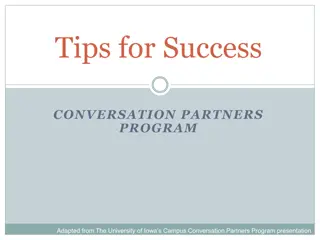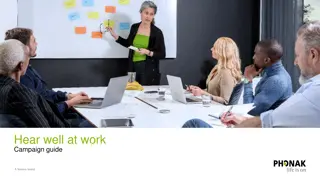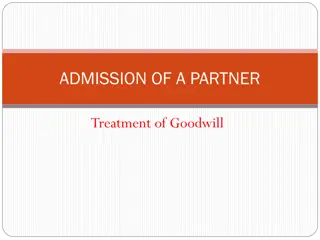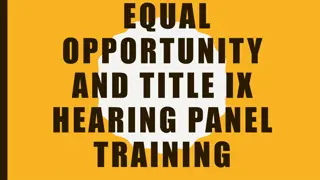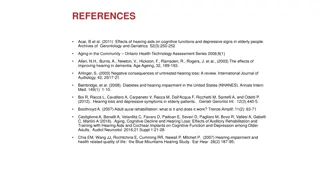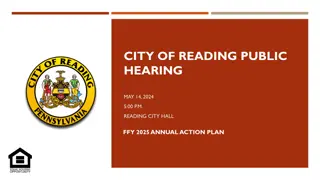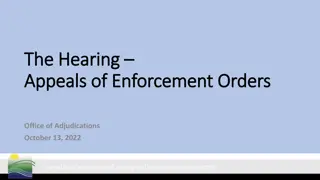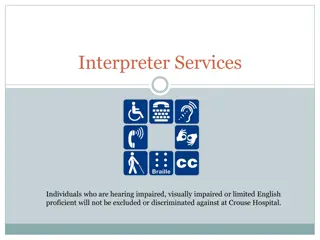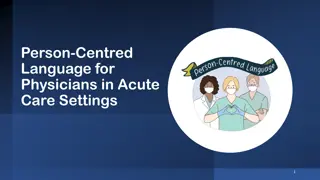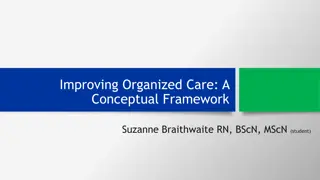Enhancing Hearing Care Through Communication Partners
This educational presentation focuses on the role and importance of communication partners in hearing rehabilitation. It explores involving various individuals as communication partners, discusses their contributions to consultations, and emphasizes person-centered care in hearing healthcare. The content includes learning objectives, definitions of communication partners, class exercises, clinic perspectives, and communication partner roles in hearing rehabilitation.
Download Presentation

Please find below an Image/Link to download the presentation.
The content on the website is provided AS IS for your information and personal use only. It may not be sold, licensed, or shared on other websites without obtaining consent from the author. Download presentation by click this link. If you encounter any issues during the download, it is possible that the publisher has removed the file from their server.
E N D
Presentation Transcript
Involving communication partners in hearing care Dr Cherilee Rutherford, AuD Sr Audiologist, Ida Institute
Learning objectives Review current literature and evidence for involving communication partners in hearing healthcare Reflect on communication partner experiences of hearing loss and hearing care Role-play, evaluate, and design a practical way to involve communication partners in hearing consultations Describe the role and importance of communication partners in hearing rehabilitation Slide 2
01. The role and importance of communication partners in hearing rehabilitation
Definitions CP is short for communication partners . The term is used to describe those with whom the person with hearing loss communicates on a regular basis The term significant others may not properly describe the broad range of partners in communication CPs can include spouses, siblings, children, friends, relatives, colleagues, and caregivers (Manchaiah et al., 2013) Slide 4
Class exercise mind map Slide 5
A view into the clinic Slide 6
Class discussion How does the CP contribute to the consultation? How does the client experience his partner s presence in the consultation? How does the clinician experience the CP in the consultation? Slide 7
Communication partner roles in hearing rehabilitation Memory aid Emotional support Transcriber Aid in decision-making Facilitator of patient understanding/involvement Companionship Advocate for the patient Interpreter Transporter Slide 9
Who is my client? Person with hearing loss Spouse or partner? Adult children? Close family member or friend? Frequent communication partner? Slide 10 Slide 10
Third party disability Because of my partner s hearing loss, I have to constantly interpret for him/her Because of my partner s hearing loss, I have to make phone calls for him/her Because of my partner s hearing loss, I don t go out as much as I would like During social activities, I have to explain my partner s hearing difficulties to friends and family to protect him/her from embarrassing situations My partner s hearing loss causes me to feel frustrated Slide 11
Adult children in hearing rehabilitation Third party disability can extend to adult children of persons with hearing loss Adult children often have multiple responsibilities (career, raising children, supporting their parents) This increases the burden that parental hearing loss may have on them Even if adult children don t live with their parent(s), they can still have a valid and important role in hearing care Slide 12
02. Literature and evidence for involving communication partners in hearing healthcare
Video Slide 14
Class discussion Slide 15
How are family members currently involved in hearing rehabilitation? Family members typically not invited to speak Family members strongly interested to participate Family members self-select to answer questions directed to the patient Family members self-initiate to expand on patient s speaking turns Family members self-initiate questions to the audiologist Audiologist typically responds by shifting conversation back to patient CP contribution is brief and shut out of conversation between patient and audiologist (Ekberg et al., 2015) Slide 16
Communication in clinical consultations descriptive review Balance talk time Open-ended dialogue Empathetic listening Involve family members Counseling training to students Manchaiah et al (2019) Slide 17
Communication in clinical consultations descriptive review Increased hearing aid uptake Third party disability CP journey CP journey Increased hearing aid use Increased hearing aid satisfaction Slide 18
Positive experiences (Manchaiah et al, 2012) Slide 19
What do patients, family members, and clinicians want? Everyone values the involvement of the family Audiologists have an opportunity to facilitate family-centered practices within hearing rehab Patients acknowledge significant role of family members in help seeking decisions about rehab Valuable to discuss family concerns with audiologist Ekberg et al., 2015 Slide 20
03. Communication partner experiences of hearing loss and hearing care
Video Slide 22
Discussion Slide 23
Communication partner journey Contemplation Awareness Persuasion Validation CP journey CP journey Rehabilitation Adaptation Resolution Slide 24
Impact of hearing loss on communication partners Vas et al, 2017 Auditory Hearing, listening, communicating, speaking Social Self Relationships, isolation, social life, occupational, interventions Effort, fatigue, emotions, identity, stigma Slide 25
Table 1. List of Identified Domains and Subdomains That Were Classified Within the Auditory Supra-Domain. Ref..: Vas et al (2017). A Data-Driven Synthesis of Research Evidence for Domains of Hearing Loss, as Reported by Adults With Hearing Loss and Their Communication Partners. SAGE Journals. This article is distributed under the terms of the Creative Commons Attribution 4.0 License www.creativecommons.org/licenses/by/4.0/ Slide 26
Table 2. List of Identified Domains and Subdomains That Were Classified Within the Social Supra-Domain. Ref.: Vas et al (2017). A Data-Driven Synthesis of Research Evidence for Domains of Hearing Loss, as Reported by Adults With Hearing Loss and Their Communication Partners. SAGE Journals. This article is distributed under the terms of the Creative Commons Attribution 4.0 License www.creativecommons.org/licenses/by/4.0/ Slide 27
Table 3. List of Identified Domains and Subdomains That Were Classified Within the Self Supra-Domain. Ref..: Vas et al (2017). A Data-Driven Synthesis of Research Evidence for Domains of Hearing Loss, as Reported by Adults With Hearing Loss and Their Communication Partners. SAGE Journals. This article is distributed under the terms of the Creative Commons Attribution 4.0 License www.creativecommons.org/licenses/by/4.0/ Slide 28
04. Practical ways to involve communication partners in hearing rehabilitation
Before, during, and after consultations Before During After Slide 30
Practical Suggestions Invite family members to attend appointments (remember the how ) Prepare your patient and their family (Telecare tools) Seek and actively listen to family members contributions Respond openly and empathically Use tools to engage family members, e.g.: Communication Partners Communication Rings Goal Sharing for Partners Partner Journey Resources Ekberg et al (2015) Slide 31
How to Talk to Your Family About Hearing Loss Courtesy of Shari Eberts TIP 5 Explain what your hearing loss is like. TIP 2 Explain what your hearing loss is like. TIP 4 Share your emotions about your hearing loss. TIP 1 Tell them about your hearing loss. TIP 3 Bring them to your audiologist appointment. TIP 10 Bring your sense of humor. TIP 6 Teach them best practices. TIP 7 Invite them to your self-advocacy efforts. TIP 8 Create a signal for when you didn't hear. TIP 9 Experiment with new technologies. Slide 32
Cultural considerations Family involvement in medical decision-making may depend on cultural values Providers may be guided by incomplete information or cultural biases rather than patient preferences Clinicians should avoid East-West cultural stereotypes Some patients may have preferences for higher self-involvement in healthcare decisions, and lower family involvement Some patients who value social hierarchies may prefer greater family involvement Individual differences can occur within cultures, therefore avoid culture-based assumptions about family involvement to provide more effective PCC Alden et al (2017) Slide 33
Assessment of CP perspective and impact of hearing loss I have noticed that John doesn't want to socialize as much because of his hearing loss It is tiring to interpret for John when we are out socializing Questionnaires to evaluate CP perspective on partner s hearing loss Questionnaires to evaluate impact of hearing loss on CP (third party disability) Slide 34
Tools and resources Ida Institute Tools Ida Learning Hall Courses Telecare Tools Communication Rings Goal Sharing for Partners My Hearing Explained Dilemma Game Communication Tips Understanding the Elements of PCC: Involving family and friends Shared decision-making Communication Partner tools* My Hearing Explained (in PCC in the Appointment) Slide 35
05. Class activity: Create an appointment map
Class activity: Involve CPs in a hearing care consultation Select appointment type (tinnitus consultation, hearing aid fitting, vestibular rehab, diagnostic hearing test) Draw a map of how you imagine the appointment will flow and show where and how you will involve the CP Exchange maps with a classmate and provide constructive feedback on each other s maps Slide 37
Involving the CP in a hearing aid assessment appointment Share Ida Communication Tips and strategies and Ida APP Ask for CP observations in preparation of next appointment Complete Telecare Tools before next appointment Discuss options and ask client and CP what they think Offer to answer any questions Highlight communication strategies for CP Invite CP into consultation Ensure enough chairs arranged in inclusive way Give clear instructions to CP to remain quiet during testing Provide reading material on communication strategies during testing Schedule appointment Initiate appointment Gather information Perform clinical tasks Share information Management plan Close After the appointment appointment Ask client and CP how much information they prefer Provide opportunities to respond and ask questions to both parties Invite CP to attend Send CP questionnaire Send Telecare Tools for completion by both CP and client Give dedicated talk time to both client and CP Refer to information shared from both parties Thank both parties for coming in and invite to following appointment Slide 38
06. Dealing with conflict
Disagreements in audiology appointments (Ekberg et al 2014) How disagreements occur How do audiologists manage the disagreements Implications for PCC/FCC and rehabilitation Slide 40
Handling conflict This is an internal step. You might notice that you feel irritation, anger, boredom; or you might notice body language like eye rolling or a sideways glance. You can ignore conflict, but you run the risk that it will re- emerge later. 1. Notice the conflict Could we talk about what s happening here? Find a way to raise the issue without attacking. You need to pause before you rush to judgment, and you need to create space for the other person. 2. Find a non-judgmental starting point Tell me your perspective on this. Give the other person your full attention. Don t start mentally preparing your arguments. 3. Listen to their story first Used with permission from VitalTalk.org Slide 41
Handling conflict Here is my take on the issue. It seems to me that we are both interested in [e.g. the patient s well-being]. 4. Identify what the conflict is about, and articulate it as a shared interest Could we list a couple of options, then spend a minute talking about the pros and cons? 5. Brainstorm options I see how this meets your interest in Perhaps we should consider to be a good marker of whether we are going in the right direction? [Proposing a trial of something for a defined period of time may be worthwhile] 6. Look for options that recognize the interests of all involved We talk about defusing because not every conflict has a solution that everyone feels good about. Sometimes you need to agree that you don t agree. 7. Remember that some conflicts cannot be resolved Used with permission from VitalTalk.org Slide 42
Take home messages 1. Family members / CPs play a valuable role in their partner s hearing journey and can also suffer the effects of hearing loss in the form of third-party disability The involvement of family and friends is one of the foundations of person-centered care Literature suggests that CPs are not yet effectively involved in routine hearing care appointments, but many practical solutions and tools exist to facilitate their inclusion 4. Conflict may sometimes arise with clients and CPs. Listen empathically and try to find solutions that recognize the interests of all involved 2. 3. CP journey Slide 43
References 1. Alden et al., 2017. Who Decides: Me or We? Family Involvement in Medical Decision Making in Eastern and Western Countries. Medical Decision Making 38(1) 14-25. https://journals.sagepub.com/doi/pdf/10.1177/0272989X17715628. 2. Eberts, S., 2020. How to Talk to your Family About Hearing Loss. Hearing Journal. https://journals.lww.com/thehearingjournal/Fulltext/2020/03000/How_to_Talk_to_Your_Family_About_Hearing_Loss.10.aspx. 3. Ekberg et al., 2015. Family Member Involvement in Audiology Appointments with Older People with Hearing Impairment. International Journal of Audiology, Vol. 54, Issue 2, 70-76, https://www.tandfonline.com/doi/abs/10.3109/14992027.2014.948218. 4. Folashade et al., 2011. Interacting with Patients' Family Members During the Office Visit. American Family Physician, 84(7):780-4. https://www.aafp.org/afp/2011/1001/p780.html. 5. Heacock & Preminger, 2017. Communication Partner Involvement in Auditory Rehabilitation: It s Time to Include Adult Children. Perspectives of the ASHA Special Interest Groups. SIG 7, Vol. 2(Part 2). American Speech-Language Hearing Association. 6. Manchaiah et al., 2019. Communication Between Audiologist, Patient and Patient s Family Members During Initial Audiology Consultation and Rehabilitation Planning Sessions: A Descriptive Review. Journal of the American Academy of Audiology, (30)810-819. Slide 44
References 7. Manchaiah et al., 2013. Communication Partners Journey through Their Partner s Hearing Impairment. International Journal of Otolaryngology. https://doi.org/10.1155/2013/707910. 8. Manchaiah et al., 2012. The Role of Communication Partners in the Audiological Enablement/Rehabilitation of a Person with Hearing Impairment: An Overview. Audiological Medicine, 10, 21-30. 9. Preminger et al., 2015. Adult-children s Perspectives on a Parent s Hearing Impairment and Its Impact on Their Relationship and Communication. International Journal of Audiology. 10. Scarinci N, Worrall L, Hickson L., 2009. The Effect of Hearing Impairment in Older People on the Spouse: Development and Psychometric Testing of the Significant Other Scale for Hearing Disability (SOS-HEAR). International Journal of Audiology, 48(10):671 683. 11. Swanepoel D. W. and J. W. Hall, 2020. Making Audiology Work During COVID-19 and Beyond. The Hearing Journal. https://journals.lww.com/thehearingjournal/blog/onlinefirst/pages/post.aspx?PostID=59. 12. Vas et al., 2017. A Data-Driven Synthesis of Research Evidence for Domains of Hearing Loss, as Reported by Adults With Hearing Loss and Their Communication Partners. Trends in Hearing. https://doi.org/10.1177/2331216517734088. Slide 45
